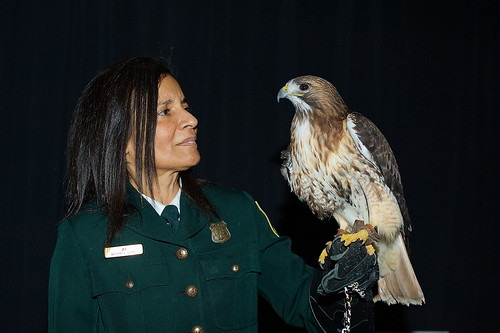
Jo Santiago, a U.S. Forest Service Wildlife Biologist who educates the public on birds through live demonstrations, shows off a Red-tailed Hawk during the “Wings Across America” event. (Photo by Sean Kelley)
When it comes to the U.S. Forest Service, it’s not always about trees.
Sometimes it’s all about the birds, the dragonflies and the butterflies. Oh, and the bats. At least, that’s what it was all about during a ceremony last month recognizing some great contributions from U.S. Forest Service and partner organizations to the Wings Across the Americas program in the past year.
In a festive event held in Omaha, Nebraska, as part of the 80th North American Wildlife and Natural Resources Conference, U.S. Forest Service employees and agency partners received shout-outs for outstanding efforts supporting migratory species across the nation and beyond.
This is a big honor to receive. Migratory species play unique ecological roles, figure prominently in culture, and are of course just plain beautiful. Despite their value, many birds, bats, butterflies, and even dragonflies unfortunately continue to face a multitude of threats. That’s why the U.S. Forest Service and its partners invest heavily in protecting habitat for migratory species, many of which spend the winter in Latin America and the Caribbean.
If habitats, not only in the United States but also in wintering locations, are not protected, the U.S. domestic investment in conservation is wasted. This is why the U.S. Forest Service works extensively in the winter ranges of many critical species as well, to develop capacity to better manage the winter homes for these animals—a small investment with a big impact.
In case you’re wondering just how much the activities of the U.S. Forest Service and their partners help these migratory species, here’s a rundown of activities recently recognized:
The first award went to the Latin American Reserve Manager Training Program in the International Cooperation category. Started in 1989, the program was the first internationally focused, hands-on, protected area training program in Latin America. RESERVA graduates manage habitats throughout Latin America that are vital for migratory species that breed on U.S. national forests and grasslands and winter south of our borders. To date, RESERVA has graduated 458 professionals, representing 23 Latin American countries & several from 5 countries outside the region.
The Urban Communities in Conservation award went to the Greater Atlanta Pollinator Partnership: A Model for Urban Pollinator Conservation. This coalition of private and public partners has worked with communities in the Atlanta metropolitan area to create and restore viable pollinator habitats by connecting private and publically owned lands through habitat corridors. The partnership demonstrates what community engagement can achieve for conservation in urban settings.
The Research Partnership Award went to the North American Bat Monitoring Program, which tackles the unprecedented threats that bats face from habitat loss and fragmentation, white-nose syndrome, wind energy development, and climate change. The North American Bat Monitoring Program documents the impact of stressors on bat populations, identifies priority species for conservation actions, and measures the effectiveness of agencies’ conservation and management actions to mitigate stressors. Partners include the U.S. Forest Service, U.S. Geological Survey, U.S. Fish and Wildlife Service, National Park Service, Department of Defense, Canadian Wildlife Service, Wildlife Conservation Society Canada, and Bat Conservation International, with assistance and input from many additional scientists and natural resource managers from the U.S., Canada, Mexico, and the United Kingdom.
The Habitat Management and Partnership Award went to Central and Southern Great Plains Migratory Bird Habitat Conservation. For more than two decades, the Rainwater Basin and Playa Lakes Joint Ventures have worked with partners to manage 200 million acres of native grassland, wetland, river and stream habitats for many important bird species across Nebraska, Kansas, Colorado, New Mexico, Oklahoma and Texas. Through public-private engagement, the nearly 70 conservation organizations and government agencies involved in the joint ventures have leveraged funding, addressed regional planning and landscape design, developed outreach and promotional materials, and collaborated with landowners to conserve the region’s bird species.
The Bird Conservation Award went to the Puerto Rican Parrot Recovery Milestone, to celebrate the wild breeding of Puerto Rican Parrots in a new area of the island. This milestone is even more impressive when we recognize that there were only 13 parrots left in the wild just 40 years ago. Partners include El Yunque National Forest, the U.S. Fish and Wildlife Service’s Puerto Rican Parrot recovery program, Puerto Rico Department of Natural and Environmental Resources and private partners. Their work has laid the foundation for future parrot population growth and for managing human use conflicts.
And the final award of the evening was in the category of Bat Conservation. The award went to Project EduBat – Education Taking Flight! The project advances bat conservation and management through robust environmental education efforts. The work taps the skills of the U.S. Forest Service, the U.S. Geological Survey, Project Underground, National Cave and Karst Research Institute, Bat Conservation International, and Prince William County Schools. Together, they have developed a wealth of new curriculum materials and resources for both formal and non-formal educators, including the only existing educational activity about white-nose syndrome.
These awards are terrific, not only because they recognize some of the outstanding work of U.S. Forest Service employees and partners, but also because they highlight the positive work carried out on behalf of a critical ecological link in America and beyond, our friends the birds, the dragonflies and the butterflies. Oh, and the bats.
No comments:
Post a Comment
Note: Only a member of this blog may post a comment.